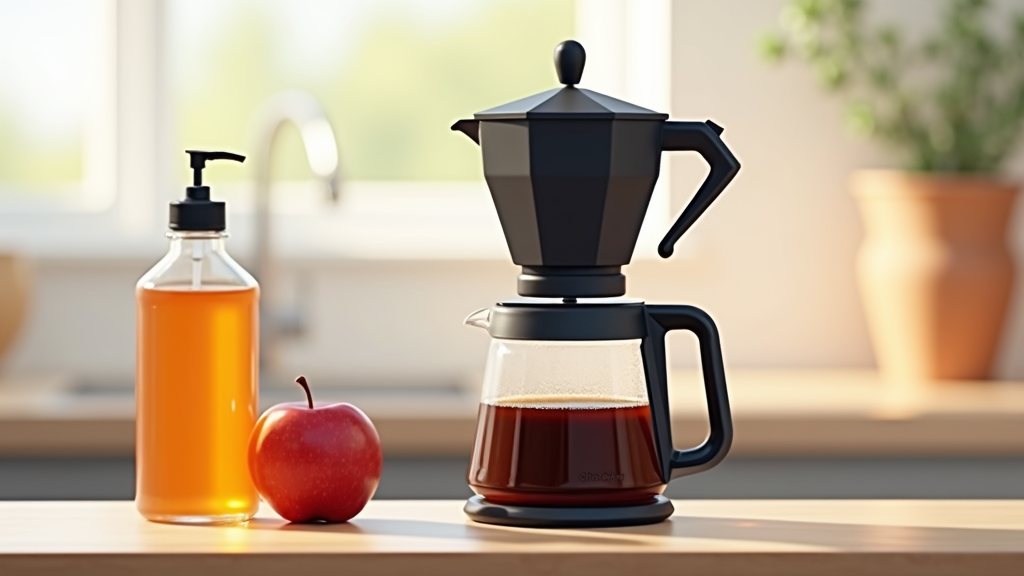Table of Contents
- Why Clean Your Coffee Maker with Apple Cider Vinegar?
- Understanding How to Clean Coffee Maker with Vinegar
- Detailed Guide: How to Clean Your Coffee Maker with Apple Cider Vinegar
- Maintaining Your Coffee Maker: Apple Cider Vinegar Cleaning
Why Clean Your Coffee Maker with Apple Cider Vinegar?

The Importance of Regularly Cleaning Your Coffee Maker
Coffee makers, essential appliances in many homes, require consistent cleaning to prevent the growth of bacteria and mold. A dirty coffee maker can harbor a surprising amount of microorganisms; in fact, studies have shown that they can contain up to 2.6 billion colony-forming units (CFU) of bacteria. Regular cleaning also prevents the buildup of residue that can significantly affect the taste of your coffee, leading to a bitter or off-putting flavor. Furthermore, mineral deposits from water can accumulate over time, potentially damaging the appliance and shortening its lifespan.
Apple Cider Vinegar: A Time-Tested Cleaning Solution
Vinegar, including apple cider vinegar, has been used as a cleaning agent for centuries, thanks to its natural acidic properties. This makes it effective at breaking down mineral deposits and sanitizing surfaces. In recent years, there’s been a growing awareness and preference for eco-friendly cleaning solutions, which has further increased the popularity of using apple cider vinegar to clean appliances like coffee makers.
What This Guide Will Teach You About Coffee Maker Cleaning
This guide provides a comprehensive outline for cleaning your coffee maker with apple cider vinegar. You’ll learn about the core concept of how the acetic acid in apple cider vinegar effectively breaks down mineral deposits and eliminates bacteria. More importantly, you’ll receive step-by-step instructions that can be applied to various types of coffee makers, ensuring a thorough and safe cleaning process.
Understanding How to Clean Coffee Maker with Vinegar
Fundamental Concepts: Cleaning Coffee Maker with Vinegar
When discussing how to clean coffee maker with apple cider vinegar, it’s crucial to understand a few key definitions. Descaling refers to removing mineral buildup from appliances. Mineral buildup consists of calcium and lime deposits left behind by hard water. Acetic acid is the active ingredient in apple cider vinegar that makes it an effective cleaning agent.
The core principle behind using apple cider vinegar to clean coffee maker is that the acetic acid gently dissolves these mineral salts without damaging the machine’s internal components. This makes it a safe and effective alternative to harsh chemical cleaners.
Essential Components for Cleaning Coffee Maker with Vinegar
To properly clean coffee maker with apple cider vinegar, you’ll need a few essential components. These include apple cider vinegar, water, a clean sponge or cloth, and optionally, a coffee filter.
- Apple Cider Vinegar:This is the primary cleaning agent.
- Water:Used for dilution and rinsing.
- Clean Sponge or Cloth:For wiping down the exterior of the coffee maker.
- Coffee Filter (Optional):To catch any remaining sediment during the final rinse cycle.
Key Features: Acetic Acid and Coffee Maker Types
When using apple cider vinegar to clean coffee maker, consider several key features. The concentration of acetic acid in the vinegar, typically 5-6%, is important. This concentration is strong enough to dissolve mineral buildup without being too harsh.
The type of coffee maker also matters. Drip coffee makers, single-serve machines, and espresso machines may require slightly different approaches when cleaning with vinegar. For example, single-serve machines may benefit from smaller vinegar-water ratios.
Important Variations: Water Hardness and Vinegar Cleaning
An important variation to consider when cleaning coffee maker with apple cider vinegar is the hardness of the water used in your coffee maker. If you use hard water, mineral buildup will occur more quickly, requiring more frequent cleaning cycles with apple cider vinegar.
Detailed Guide: How to Clean Your Coffee Maker with Apple Cider Vinegar

**Key Takeaway:** Cleaning your coffee maker with diluted apple cider vinegar is an effective way to remove mineral buildup, but always rinse thoroughly with filtered water to avoid a lingering vinegar taste. For optimal results and to protect your machine, be sure to consult your manufacturer’s guidelines and avoid using undiluted vinegar.
Preparation Steps for Cleaning Coffee Maker with Vinegar
Before you begin cleaning your coffee maker, gather the necessary materials and prepare your workspace. This will streamline the cleaning process and ensure you have everything you need.
- Required materials:
- Apple cider vinegar (1 cup)
- Water (2 cups)
- Clean sponge or cloth
- Coffee filter (optional)
- Measuring cup
Start by setting up your cleaning area and ensuring the coffee maker is ready for the process.
- Initial setup:
- Unplug the coffee maker and allow it to cool completely.
- Remove any leftover coffee and used coffee grounds from the machine.
- Rinse the carafe and filter basket with warm water to remove loose debris.
When working with vinegar, it’s important to consider ventilation.
- Important considerations:Ensure adequate ventilation in your kitchen or cleaning area due to the strong smell of vinegar. Open windows or use a ventilation fan.
Step-by-Step Process: Cleaning Your Coffee Maker with Vinegar
Follow these detailed instructions to effectively clean your coffee maker using apple cider vinegar. Each step is crucial for removing mineral buildup and ensuring your coffee maker functions optimally.
Follow these best practices for optimal cleaning results.
- Best practices:
- Use filtered water for rinsing to prevent further mineral buildup in your coffee maker.
- Ensure thorough rinsing after the vinegar cycle to remove any lingering vinegar taste.
Avoid these common mistakes to protect your coffee maker and ensure a successful cleaning process.
- Common mistakes to avoid:
- Using undiluted vinegar, which can be too harsh and potentially damage the machine.
- Not rinsing the coffee maker thoroughly, which can leave a noticeable vinegar taste in future brews.
- Ignoring the manufacturer’s guidelines for cleaning, which may void your warranty or harm your machine.
Advanced Techniques for Deep Cleaning Coffee Makers with Vinegar
For coffee makers with heavy mineral buildup or persistent odors, consider these advanced cleaning techniques to achieve a deeper clean.
- Expert tips:
- For heavily scaled coffee makers, let the vinegar solution sit in the reservoir overnight to dissolve stubborn mineral deposits.
- Add a small amount of baking soda to the final rinse cycle to help neutralize any lingering vinegar odors.
Implement these optimization methods to maintain your coffee maker’s cleanliness and performance over time.
- Optimization methods:
- Use a water softener if you live in an area with hard water to reduce mineral buildup in your coffee maker.
- Clean removable parts with hot water after each use to prevent coffee oils and residues from accumulating.
If you encounter any issues during the cleaning process, refer to these troubleshooting tips.
- Troubleshooting:
- If the vinegar smell persists after multiple rinse cycles, run additional cycles with plain water until the odor is gone.
- Consult your coffee maker’s manufacturer guidelines for specific error codes or descaling instructions.
Maintaining Your Coffee Maker: Apple Cider Vinegar Cleaning
Optimal Cleaning Frequency Using Apple Cider Vinegar
It’s recommended to clean your coffee maker with apple cider vinegar every 1 to 3 months. This schedule can vary depending on a few factors. If you use your coffee maker daily or live in an area with hard water, more frequent cleaning is beneficial. Regular cleaning prevents scale buildup from mineral deposits, ensuring your coffee tastes its best and extends the life of your machine.
Benefits of Apple Cider Vinegar in Coffee Maker Cleaning
Using apple cider vinegar to clean your coffee maker offers several advantages. It’s an affordable and eco-friendly cleaning solution, relying on a common kitchen ingredient. Apple cider vinegar effectively maintains the quality and hygiene of your coffee maker. Plus, it acts as a multipurpose cleaning agent for other household tasks. A gallon of apple cider vinegar is cost-effective, typically priced around $5, making it a budget-friendly option. It also helps neutralize odors, leaving your coffee maker smelling fresh.
Safety and Precautions When Cleaning with Vinegar
Before you begin, ensure your coffee maker is unplugged. Handle hot water with caution to avoid burns. Be mindful of using apple cider vinegar on machines with specific cleaning guidelines or components sensitive to acidity. Always check the user manual for any specific recommendations or warnings related to your coffee maker model. Following these precautions ensures a safe and effective cleaning process.
Alternatives to Apple Cider Vinegar for Coffee Maker Cleaning
While apple cider vinegar is a great choice, white vinegar can be used as a substitute. However, apple cider vinegar is often preferred due to its milder acidity and less pungent odor. For heavily scaled coffee makers, commercial descaling solutions are also available. Avoid using bleach, as it can damage the coffee maker and leave behind unpleasant odors. Choose the cleaning method that best suits your needs and preferences.
Effectively Removing Vinegar Odor After Cleaning
If a vinegar smell persists after cleaning, run additional cycles with plain water until the odor dissipates. For stubborn odors, use water with a small amount of baking soda (1 teaspoon per pot) to neutralize the smell, followed by rinsing with plain water. This ensures your coffee maker is fresh and ready for your next brew.

